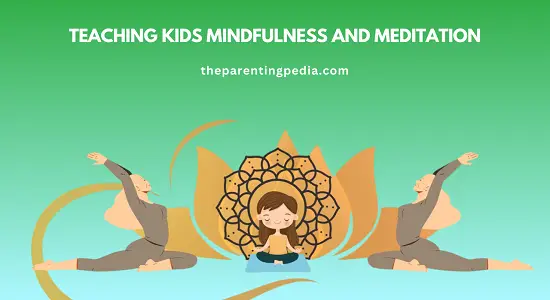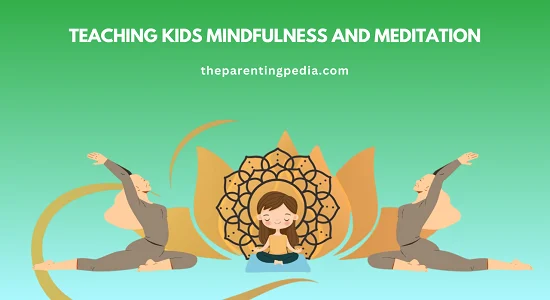Mindfulness and meditation are valuable practices that help children enhance emotional awareness, improve focus, and build resilience. In today’s fast-paced world, children often encounter stress and distractions from school, social pressures, and technology. Teaching mindfulness and meditation equips children with vital skills to handle life’s challenges, develop emotional intelligence, and promote a sense of inner peace. This article offers guidance on how to introduce mindfulness and meditation to children, supporting them through their formative years.
Understanding Mindfulness And Meditation For Kids
Mindfulness: Mindfulness is the practice of being fully present and aware of the moment without judgment. For children, it involves paying attention to their thoughts, emotions, and surroundings in a calm and focused way.
Meditation: Meditation is a technique often used to cultivate mindfulness. It involves specific practices like focusing on the breath, repeating a mantra, or visualizing peaceful scenes to increase focus and attention. Meditation helps calm the mind and develop self awareness. For kids, mindfulness and meditation are not about sitting still for long periods or achieving perfect focus. Instead, they are fun, age-appropriate practices that can be incorporated into daily routines to promote calmness, empathy, and focus in them.
Benefits Of Mindfulness And Meditation For Kids
Introducing meditation to children can have numerous positive effects, including:
Improved Focus and Concentration: Meditation practices enhance attention span, which can help children perform better academically and stay engaged in activities.
Emotional Regulation: Meditation teaches children to identify and manage their emotions, reducing anxiety and helping them respond calmly to stress.
Better Sleep: Mindfulness helps calm a racing mind, promoting restful sleep in children.
Enhanced Empathy: Practicing mindfulness and meditation promotes kindness and compassion in children, encouraging them to understand and care for others.
Resilience: Meditation helps children develop a sense of inner strength, enabling them to cope with challenges and setbacks more effectively.
How To Introduce Mindfulness And Meditation To Kids
Start With Simple Concepts: Introduce meditation as fun, approachable activities. Use simple language that children can understand. Keep explanations simple and relatable.
Make It Age Appropriate: Introduce mindfulness practices according to the child’s age and developmental stage:
For younger children: Use playful activities like mindful breathing with a stuffed animal, where they watch it rise and fall on their belly.
For older children: Introduce simple meditations or mindfulness exercises to reflect on their emotions.
Keep Sessions Short: Children have shorter attention spans, so start with brief sessions of 2–5 minutes. Gradually increase the duration as they become more comfortable with the practice.
Easy Mindfulness Activities For Kids
Here are some simple mindfulness activities for children:
Mindful Breathing: Teach children to focus on their breath as a way to calm their mind.
- Ask them to sit comfortably, close their eyes, and take slow, deep breaths.
- Encourage them to notice the sensation of air entering and leaving their nose or how their chest rises and falls.
- Use toys like a stuffed animal for younger kids to make it more engaging.
Body Scan: Guide children to connect with their bodies to increase self-awareness:
- Have them lie down or sit comfortably.
- Ask them to focus on each part of their body, starting with their toes and moving upward, noticing sensations like warmth or tension.
Five Senses Exercise: This activity helps kids ground themselves by focusing on their senses. Five senses exercise include activities such as asking them to identify five things they can see, four they can touch, three they can hear, two they can smell, and one they can taste.
Gratitude Practice: Help develop gratitude in children. At the end of the day, ask kids to name three things they are grateful for. Encourage them to reflect on why these moments were special.
Visualization: Use guided imagery to help children relax and focus. Ask them to close their eyes and imagine a peaceful place, such as a beach or forest, and describe what they see, hear, and feel.

Introducing Children With Meditation Techniques
Meditation does not have to be rigid or intimidating for kids. Here are some kid friendly techniques for children:
Breathing Meditation: Focus on the rhythm of breathing. Guide them to breathe in for a count of four, hold for a count of two, and exhale for a count of four. This technique helps calm anxiety and improve focus in children.
Loving-Kindness Meditation: Encourage kindness and compassion in children. Have kids sit comfortably and repeat phrases like, “I am happy, I am healthy,” and extend these wishes to friends and family.
Movement Meditation: Combine meditation with movement and simple exercises. Activities like yoga, tai chi, or simply walking mindfully can help active children engage with meditation in a dynamic way.
Sound Meditation: Use sounds to help children learn focus. Play soothing music, chimes, or nature sounds, and ask kids to listen carefully, noticing every detail.
Making Mindfulness And Meditation Fun
Children are more likely to embrace mindfulness when it feels enjoyable. Use these tips to make it fun:
Incorporate Stories: Use books or stories that introduce mindfulness concepts in an engaging way.
Use Apps or Videos: Use kids friendly apps can help provide interactive guided meditations techniques to children.
Create a Mindfulness Space: Set up a cozy, quiet corner with cushions, books, and calming objects for meditation practices.
Be Creative: Turn mindfulness into a game, like pretending to be mindful detectives who notice every sound, color, or texture.
Integrating Mindfulness into Daily Life
Mindfulness does not have to be a separate activity. It can be incorporated into everyday routines:
Morning Routine: Start the day with a few moments of mindful breathing or intention-setting.
During Meals: Practice mindful eating by focusing on the taste, texture, and smell of food.
Also Read: Helping Children Embrace And Learn From Failure
Bedtime Ritual: Use a body scan or gratitude practice to unwind before sleep.
Transitions: Use meditation techniques to ease transitions, such as breathing exercises before starting homework or calming visualization after a busy day.
Challenges And How To Overcome Them
Introducing mindfulness to kids may come with challenges, such as restlessness or lack of interest. Here is how to address such challenges:
Be Patient: Children may take time to understand and embrace mindfulness. Avoid forcing it and celebrate small efforts.
Lead by Example: Practice mindfulness yourself. Children often learn best by observing their parents.
Adapt and Experiment: If one method does not work, try another. Every child is different, so explore various techniques until you find what resonates.
Focus on the Process: Emphasize the joy and relaxation of the ongoing practice rather than achieving specific outcomes.
Conclusion
Introducing mindfulness and meditation to kids provides them with essential tools for emotional resilience, focus, and self-awareness. By learning these practices, children learn to manage stress, improve concentration, and develop empathy. Starting with simple, age-appropriate activities and integrating mindfulness into daily routines makes the process enjoyable and sustainable. Patience and consistency are key, as children grow to appreciate the benefits over time. These practices not only nurture their mental well-being but also strengthen family connections and lay the foundation for a balanced and mindful approach to life, empowering them to face challenges with confidence and calmness.
FAQ
How do you explain mindfulness to a child?
Mindfulness means paying attention to the present moment with curiosity and kindness. It can be practiced by taking deep breaths, focusing on what you see or hear, and calming your mind to feel peaceful and happy.
How to teach kids mindfulness meditation?
Teach kids by starting with simple, fun activities. Guide them to sit comfortably and focus on their breathing, imagining their belly as a balloon. Use games like five senses exercise to keep them engaged. Keep sessions short, consistent, and age-appropriate, emphasizing relaxation and curiosity over perfection.
